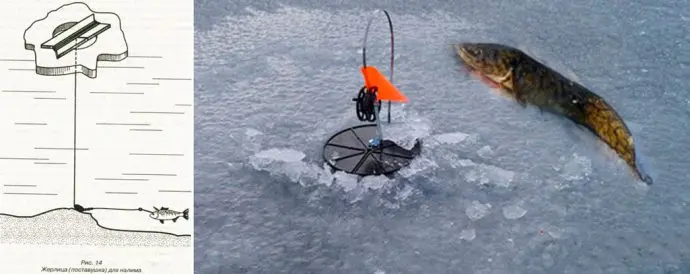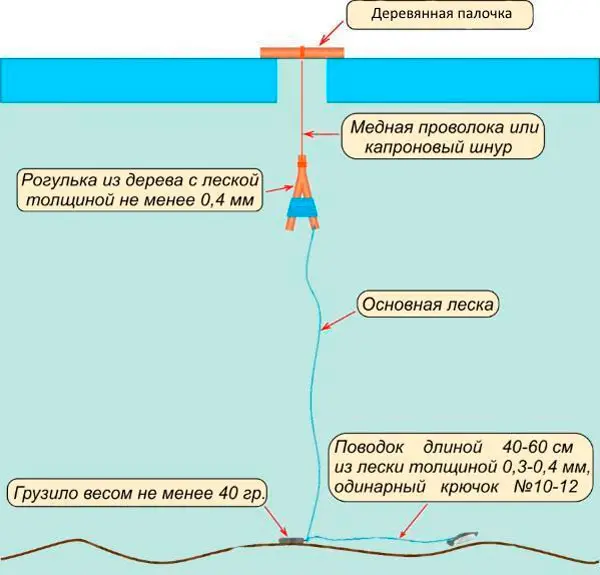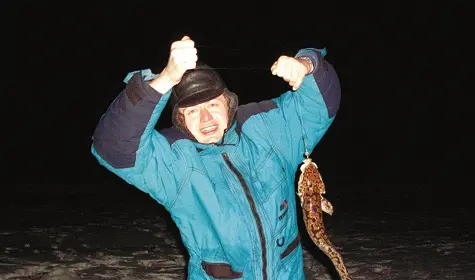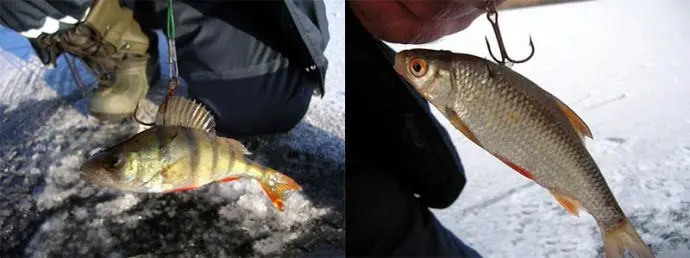Contents

Zherlitsa is a winter tackle for catching predatory fish, such as pike or zander. At the same time, this tackle can be used for catching burbot. Burbot is rarely caught with artificial lures. Therefore, the most common bait is live bait. Despite this, burbot can peck at dead fish.
Burbot is an extremely interesting fish and is characterized by the fact that when real cold weather sets in, it shows maximum activity. It belongs to the family of cod fish species and is the only representative living in fresh water. It can grow in length up to one and a half meters, with a weight of 20 kg or more. But such instances are quite rare. Such specimens can be found in fairly large rivers, such as the Volga or Lena. And then, a trophy specimen is most often available to an experienced angler, although luck also takes place.
In addition to the characteristic features that distinguish this type of fish from other species common in rivers, burbot has very tasty meat. From the meat of this fish, the most rich and tasty fish soup is obtained.
Tethers for catching burbot

They catch this fish with the most common vents designed for pike fishing. This tackle consists of a stand with a reel of fishing line attached to it and a flag signaling a bite. It is installed on the hole, while the flag is set to standby for a bite. When the fish bites, the flag is set to a vertical position, indicating a bite.
You can also find a simpler design of the vent, which is called a postavushka. This is a very simple design that can be built in a few minutes directly at the fishing site from improvised materials.
For this, a stick is taken, slightly longer than the diameter of the hole. The second element is a wooden spear made of the same wood, attached to the first element – a stick. This type of vent is also called underwater, as it is installed with a flyer down, under water. A fishing line is wound on one part of the flyer, and a slot is made on the second, for which the fishing line is fixed. When biting, the fishing line is pulled out of this crevice and begins to unwind from another part of the slingshot. A similar type of zherlitsy is installed at night. As a rule, the hole has time to freeze during the night, but since the main part of the vent is under water, this does not affect its functional characteristics, and it remains in working condition.
At least 10 meters of fishing line should be wound on one part of the flyer. It all depends on the depth of the reservoir, and you also need a margin so that the burbot, taking the bait, can move a certain distance. At the same time, it is not recommended to wind too much fishing line, otherwise the fish will be able to get the tackle into snags and confuse. At the time when the line is being unwound, the burbot will swallow the bait well, and when the line is over, he will put himself on the hook.

Installation of girders
The installation of vents is a laborious task that has a specific approach in terms of drilling holes. The approach assumes:
- Punching holes in a zigzag pattern.
- In a straight line.
- Drilling holes in an arc.
- The arrangement of holes in a checkerboard pattern.
In this case, the choice of a scheme for the location of the holes depends on the nature of the reservoir, as well as on the location of the burbot, which is not defined. A different pattern of hole punching provides the ability to determine the bottom topography. As far as we know, burbot prefers depth, therefore, it is very important to find places with greater depth. It is on such holes that you can expect burbot bites. Such places can be classified as promising places.
Anglers try to set the maximum possible number of vents, which increases the chances of a catch. And yet, you need to remember that only promising places can give a fish. Therefore, you should not especially count on bites on non-promising holes. This is exactly the case when experience, knowledge, as well as the time spent on determining the bottom topography, can be decisive factors in terms of fishing performance. A similar approach to the fishing process can be considered optimal, which allows you not to install extra gear. This, in turn, saves valuable time and the emphasis is not on quantity, but on quality.
Bait fishing in winter. Installation of girders on burbot.
Equipment zherlitsy on burbot
Since burbot is not a pike, the equipment is somewhat simplified due to the rejection of a metal leash. Although, there is a high probability of pike biting. Therefore, the choice is up to the angler, especially if he is familiar with the reservoir. If the reservoir is not familiar, then you can play it safe and install a metal leash. Many anglers point to the fact that the burbot is not alarmed by the leash, and it equally actively pecks at the tackle, both without a leash and with a leash.
And yet, tackle designed to catch this fish must have certain characteristics. This is due to the fact that a bite of a large specimen is possible.
The rig should be as follows:
- The main fishing line, with a diameter of 0,4-1,0 mm.
- Leash, 0,5 m long and up to 0,4 mm thick.
- Cargo, weighing 40-100 g, depending on the strength of the current.
Catching burbot in winter

Winter is the height of burbot activity, when other fish species are either in a stupor or in a state of suspended animation. And since burbot has delicious meat, it becomes the object of fishing for many winter fishing enthusiasts. The colder it is outside, the more likely it is to catch a burbot. The more frost, the greater the chances of a big catch. With the advent of warming, the biting of burbot becomes more unpredictable and irregular. In short, on those days when there is no desire to go fishing, burbot can be as active as possible.
At the same time, it should be noted that burbot in winter bites both during the day and at night, despite the fact that it is mainly a nocturnal hunter, like most underwater predators. This is due to the fact that burbot is a cold-loving fish, plus everything under the ice is difficult to distinguish day from night and vice versa.
Despite this, more productive fishing will be in night time. According to experts, it eats 2 times and is most actively caught from 21:24 to 3:5 in the evening and from XNUMX:XNUMX to XNUMX:XNUMX in the morning. It is during these periods of time that fishing for burbot acquires the greatest interest.
Burbot is active throughout the winter, from autumn to spring. Burbot spawns in December-January. During the spawning period, he may refuse to eat, but not for long. The spawning period depends on the nature of the reservoir. In some reservoirs, it spawns in the month of February. It is unrealistic to predict this period, since weather conditions can intervene here. When the water temperature rises to +10°C, burbot ceases to lead an active lifestyle and goes to rest. With a further increase in temperature, this fish hibernates. In this state, he is until the onset of cold weather.
What do they catch burbot in winter

Since burbot is a predator, its menu includes food of animal origin. The following baits are suitable for catching it:
- Zivec;
- dead fish;
- Pieces of fish;
- Crawl out.
Burbot is best caught on live bait and this is not surprising, since small fish are included in his daily diet. Other types of baits are less effective and only work on those waters where there is a large population of burbot. This mainly applies to artificial baits. When using crawls, it should be borne in mind that other types of fish, including peaceful ones, also love them. A dead fish attracts burbot just as much as its pieces, as well as pieces of meat, but the live bait is the most catchy bait.
As live bait, you can use small individuals of the following species of fish:
- Ruff;
- perch;
- Sandblaster etc.
Promising burbot places

If we are talking about an unfamiliar body of water, then the question is very serious. To find a promising place will have to work hard. At the same time, you need to know for sure whether burbot is found in this reservoir or it is not here, and then all searches will be in vain.
First, you need to drill several dozen holes, using a certain scheme for this, depending on the nature of the reservoir. The more vents, the more chances to find a place of dispersal of burbot. At the same time, one must take into account the fact that in these regions a limit on the use of girders is legally established. To avoid conflict with the law, every angler should know these rules.
If one of the gear worked, then in this place, and this fish is located. At the same time, it makes no sense to install gear on holes where there are no bites. If a burbot trail is found, it will ensure the capture of several individuals at once, and then over the next days we can expect good results in terms of catching burbot. The outcome of fishing mainly depends on how well the place for fishing is chosen. One cannot do without measuring the depths, so you will have to spend some of your precious time on this procedure. But first you need to make holes. The hole from the hole can be located at a distance of 10 to 20 meters. Their number can be at least 10, and they can be arranged in a checkerboard pattern. This approach is relevant when the reservoir is unfamiliar. As for the familiar reservoir, every angler knows all the differences in depths, pits, edges, dumps, etc.
Burbot prefers to stay in deep places, and when it gets warmer, it shifts even deeper and this factor should be taken into account. This process is especially active at the end of winter. In winter, when it is very cold, burbot can be found in areas where the depth is negligible. These can be gently sloping coasts, beaches, shallows that turn into dumps.
If a burbot parking spot is found, we can safely say that fishing is provided for the entire season. The main thing is to demonstrate desire and patience, which will then result in productive fishing.
It should be noted, in conclusion, that burbot is a unique fish. This can be said to be the only type of fish that is not caught in the summer, but shows maximum activity in the dead of winter. In addition, it spawns in fairly cold water, which is not capable of any kind of fish that is found in our rivers. This factor has a positive effect on the survival of burbot. The appearance of eggs is unlikely to awaken the appetite of most predators, which show a minimum of activity in winter.
Video “Nuances in equipment and fishing practice”
Burbot and girders: nuances in equipment and fishing practice









